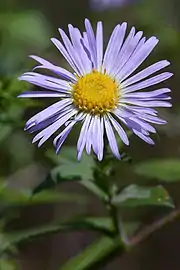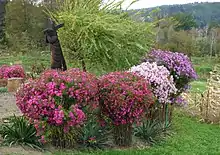Symphyotrichum novae-angliae
Symphyotrichum novae-angliae (formerly Aster novae-angliae), the New England aster,[2] hairy Michaelmas-daisy,[3] or Michaelmas daisy, is a species of flowering plant in the family Asteraceae. It is a perennial, herbaceous plant native to eastern North America, and has been introduced to Europe. The seeds and nectar of this fall-flowering species are important to a wide variety of animals. Numerous cultivars have been developed and the species is a popular garden plant, especially in Europe.
| New England aster | |
|---|---|
 | |
| New England aster blooming in Addington Highlands (Ontario, Canada). | |
| Scientific classification | |
| Kingdom: | Plantae |
| Clade: | Tracheophytes |
| Clade: | Angiosperms |
| Clade: | Eudicots |
| Clade: | Asterids |
| Order: | Asterales |
| Family: | Asteraceae |
| Genus: | Symphyotrichum |
| Subgenus: | Symphyotrichum subg. Virgulus |
| Species: | S. novae-angliae |
| Binomial name | |
| Symphyotrichum novae-angliae | |
| Synonyms | |
|
List
| |
Description
New England aster is a perennial, herbaceous plant between 30 and 120 cm (12 and 47 in) tall. It is cespitose, with several erect stems emerging from a single point. The stems are stout, hairy, and mostly unbranched. The untoothed, lance-shaped leaves clasp the stem. Flowering occurs from August to November, with the lower leaves often withering by the time of flowering. The abundant flower heads are showy with yellow disc florets at the center and ray florets that range from a deep purple or rose pink to rarely white. Many cultivars have been developed which may differ from the characteristics listed above in various ways.[4]
 Clasping leaves and hairy stem
Clasping leaves and hairy stem Pale-colored flower
Pale-colored flower.jpg.webp) Flowering with goldenrod (Solidago)
Flowering with goldenrod (Solidago)
Taxonomy

Symphyotrichum novae-angliae was formerly included in the large genus Aster as Aster novae-angliae. However, this broad circumscription of Aster is polyphyletic and the North American asters are now mostly classified in Symphyotrichum and several other genera.[5]
Several forms of this species have been recognized, differing in flower color, but these are not recognized in most sources.[4][6]
Hybridization with Symphyotrichum ericoides is frequent where the ranges of these two species overlap. Hybrids are called Symphyotrichum × amethystinum and are intermediate between the parent species in most respects. No other hybrids with Symphyotrichum novae-angliae have been recorded.[6]
The vernacular name "Michaelmas-daisy" derives from the various asters, including this species, that tend to flower around September 29, the feast of St. Michael.
Distribution
New England Aster is native to most of the central and northeastern United States and southeastern Canada, from Manitoba south to Louisiana and east to Maine. It is absent from the far southeastern United States and from boreal regions in Canada. There are isolated populations to the west of the main range, such as in New Mexico and in the Black Hills of South Dakota.[6]
Due to widespread cultivation, introduced populations are present elsewhere in North America and in other parts of the world. In North America, introduced populations are present in Nova Scotia,[6] Montana, Oregon, Utah, Washington, Wyoming, and likely elsewhere.[4] It is widely naturalized throughout most of Europe and parts of Central Asia.[7][8] It is also naturalized in New Zealand.[9]
Habitat
The species is found in a wide variety of open, typically moist habitats, including meadows, prairies, marshes, fens, forest edges, and disturbed anthropogenic habitats such as roadsides and former agricultural fields.[4][10] The soils where it grows are often calcareous.[6]
Ecology

Symphyotrichum novae-angliae reproduces vegetatively via short rhizomes, and via wind-dispersed seeds. The species is largely incapable of self-pollination, and requires cross-pollination for seed production. The seeds are an important food source for songbirds.[6]
A wide variety of generalist nectar-feeding insects visit Symphyotrichum novae-angliae, including butterflies, moths, ants, flies, and bees. It is heavily visited by long-tongued bumblebees like Bombus fervidus and Bombus vagans, and less so by short-tongued species. Some bees will collect pollen in addition to nectar, such as Megachile latimanus and Melissodes druriella.[6][10]
A gall midge, Rhopalomyia astericaulis, produces a 2 cm (0.8 in) stem gall on this species. Leaf-mining insects include beetles (Sumitrosis inaequalis, Systena hudsonias. and Microrhopala xerene) and flies (Agromyza curvipalpis, Agromyza platypera, Napomyza lateralis, and Phytomyza albiceps).[6] Butterflies known to feed on New England aster as caterpillars include the Gorgone checkerspot (Chlosyne gorgone)[6] and pearl crescent (Phyciodes tharos).[11] The beetle Exema canadensis breeds on S. novae-angliae.[10]
Fungi known to affect the species include Basidiophora entospora, Coleosporium asterum,[10] Discosphaerina pseudhimantia, Erysiphe cichoracearum, Gibberidea heliopsidis, Placosphaeria haydeni, Puccinia asteris, Ramularia asteris, Ramularia macrospora, and Septoria atropurpurea.
Uses
Cultivation

Over 70 cultivars of have been developed, although only about 50 survive in commerce today. There is less diversity of habit and flower than in cultivars of Symphyotrichum novi-belgii, which are often derived from hybrids. The novae-angliae cultivars grow to between 90 and 180 cm (35 and 71 in) in height, with the notable exception of ‘Purple Dome’, at under 60 cm (24 in).[12] The cultivar 'Harrington’s Pink' has gained the Royal Horticultural Society’s Award of Garden Merit.[13][14] Long popular in Europe, where it was introduced in 1710,[12] New England aster has only more recently become commonly cultivated in North America.[6]
Medicinal use
As a common, widespread plant, this species has been widely used for medicinal purposes among indigenous people in North America. Documented uses include:
- Among the Cherokee, a poultice of the roots for pain, an infusion of the roots for diarrhea, sniffing the ooze from the roots for catarrh, and an infusion of the plant for fever.[15]
- Among the Chippewa, smoking the roots in pipes to attract game.[16]
- Among the Iroquois, a decoction of the plant for weak skin, a decoction of the roots and leaves for fevers, and an infusion of whole plant and rhizomes from another plant to treat mothers with intestinal fevers.[17][18]
- Among the Meskwaki, smudging the plant and using it to revive unconscious people.[19]
- Among the Potawatomi, using it as a fumigating reviver.[20]
References
- "Symphyotrichum novae-angliae". NatureServe Explorer. NatureServe. Retrieved 2007-06-18.
- "Symphyotrichum novae-angliae". Natural Resources Conservation Service PLANTS Database. USDA. Retrieved 6 December 2015.
- "BSBI List 2007". Botanical Society of Britain and Ireland. Archived from the original (xls) on 2014-10-23. Retrieved 2014-10-17.
- Brouillet, Luc; Semple, John C.; Allen, Geraldine A.; Chambers, Kenton L.; Sundberg, Scott D. (2006). "Symphyotrichum novae-angliae". In Flora of North America Editorial Committee (ed.). Flora of North America North of Mexico (FNA). 20. New York and Oxford – via eFloras.org, Missouri Botanical Garden, St. Louis, MO & Harvard University Herbaria, Cambridge, MA.
- Semple, J. C. "An overview of "asters" and the Tribe Astereae". University of Waterloo. Retrieved 22 January 2020.
- Chmielewski, J. G.; Semple, J. C. (2003). "The biology of Canadian weeds. 125. Symphyotrichum ericoides (L.) Nesom (Aster ericoides L.) and S. novae-angliae (L.) Nesom (A. novae-angliae L.)". Canadian Journal of Plant Science. 83 (4): 1017–1037. doi:10.4141/P01-179.
- Lakusic, Dmitar; Jovanociv, Slobodan (2012). "Symphyotrichum novae-angliae (Compositae) new alien species in Serbia". Botanica Serbica. 36 (1): 67–70.
- "Symphyotrichum novae-angliae (L.) G.L.Nesom". Plants of the World Online. Royal Botanic Gardens, Kew. Retrieved 6 February 2020.
- "NZOR Name Details - Symphyotrichum novae-angliae (L.) G.L.Nesom". www.nzor.org.nz. Retrieved 6 February 2020.
- Wilhelm, Gerould; Rericha, Laura (2017). Flora of the Chicago Region: A Floristic and Ecological Synthesis. Indiana Academy of Sciences.
- The Xerces Society (2016), Gardening for Butterflies: How You Can Attract and Protect Beautiful, Beneficial Insects, Timber Press.
- "Aster novae-angliae (New England Aster; Michaelmas Daisy)". Colwall, United Kingdom: The Picton Garden and Old Court Nurseries.
- "RHS Plantfinder - Symphyotrichum novae-angliae 'Harrington's Pink'". Retrieved 30 November 2018.
- "AGM Plants - Ornamental" (PDF). Royal Horticultural Society. July 2017. p. 100. Retrieved 30 November 2018.
- Hamel, Paul B. and Mary U. Chiltoskey 1975 Cherokee Plants and Their Uses – A 400 Year History. Sylva, N.C. Herald Publishing Co. (p. 24)
- Densmore, Frances 1928 Uses of Plants by the Chippewa Indians. SI-BAE Annual Report #44:273-379 (p. 376)
- Herrick, James William 1977 Iroquois Medical Botany. State University of New York, Albany, PhD Thesis (p. 463)
- Rousseau, Jacques 1945 Le Folklore Botanique De Caughnawaga. Contributions de l'Institut botanique l'Université de Montréal 55:7-72 (p. 65)
- Smith, Huron H. 1928 Ethnobotany of the Meskwaki Indians. Bulletin of the Public Museum of the City of Milwaukee 4:175-326 (p. 212)
- Smith, Huron H. 1933 Ethnobotany of the Forest Potawatomi Indians. Bulletin of the Public Museum of the City of Milwaukee 7:1-230 (p. 50)
External links
| Wikimedia Commons has media related to Symphyotrichum novae-angliae. |
| Wikispecies has information related to Symphyotrichum novae-angliae. |
